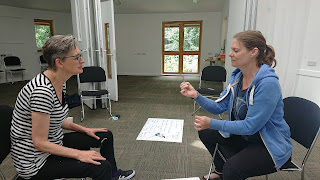THE REWILDING PROJECT: Rewilding Engineer Workshop at Lewes Railway Land Wildlife Trust!
In late July, Dylan Walker of Wilderlife teamed up with Railway Land Wildlife Trust and Small PerformanceAdventures to run a three-day Rewilding Workshop in Lewes, East Sussex.
Becoming a Rewilding Engineer
On the course we went behind the
scenes with some of our most charismatic wild animals. Together we tried to
understand what made wild horses, bears, and beavers tick. What did they do all
day? And how did their efforts create opportunities for other creatures to
thrive?
With two highly competitive teams choosing
a charismatic species each, each team was soon using their new found knowledge,
crafting skills, and creative thinking to recreate a day in the life of an
extinct animal!
As rewilding engineers, Team A chose
the wolf, whilst Team B chose wild cattle (the Aurochs), and specifically, the
bull! Both teams were tasked with replicating the behaviour of their extinct
species in a way that would be beneficial to other plants and animals. Whether
through artistic interpretation or direct impact, we were looking for a
positive impact on nature whilst gaining a deep insight into the importance of
animals that once shaped our landscape and created niches for so many other
creatures!
 |
| Kate and Helen play the seed dispersal game'Cockerel and Hen' |
Wolves and Aurochs back in Lewes!
The results from both teams were
outstanding:
Team A created wolf footprints from
plaster and took the first wolf steps on the Railway
 |
| Hand made wolf footprints alongside domestic dog prints |
Meanwhile, the wild cattle dug their
very own bull pit! A bull pit is an area of ground pounded and scuffed by a
bull until a pit is created with large patches of bare earth. The bull uses the
pit as a mating site to attract females, but the disturbed ground is fantastic
for other wildlife, including digger wasps, annual flowers such as poppies,
basking wall brown butterflies and thermo-regulating snakes. In a ritual
worthy of any pagan festival, Team B’s Ronan read a wonderful poem reinstating
the aurochs as part of our cultural heritage, while the rest of the team mooed
and mock stamped the ground to complete the bull pit ceremony! The team also
used a shawl as a seed dispersant, imitating the importance of seeds carried in
the fur of cattle in order to enable plants to move and germinate in new
locations!
Bringing it back to us!
Finally, we all took on the role of
the biggest ecosystem engineer of all time – us humans! We went back to our
ancestral beginnings and thought about how we, like our ancestors, can give
back to nature and get so much more in return. We also took time out around the
reserve to understand how ecosystems function, the basic principles of
rewilding, and how to use all of our senses to connect with the natural world!
I’d like to say a huge thanks to
everybody involved in the organising of the workshop; to Helen Meade of the
Railway Land Wildlife Trust, and to Kate McCoy of Small Performance Adventures,
as well as all of the other participants: Paul,
Jane, Warner, Ronan, Lesley, and Jennie. The way that everybody immersed
themselves in the challenge and came up with such creative results was a joy to
see!
I’ll leave you with Ronan’s excellent poem on the mighty
Aurochs:
Wolves V Aurochs



It was such a lovely learning opportunity and you created a space that made it easy to be creative. We had great fun. I've mentioned the workshop to friends and its provoked great curiosity and made for interesting conversations. Thanks Ronan
ReplyDelete